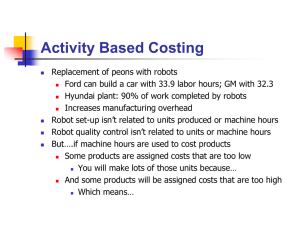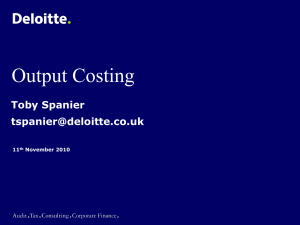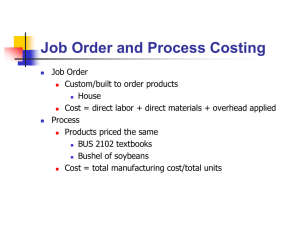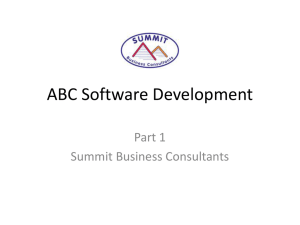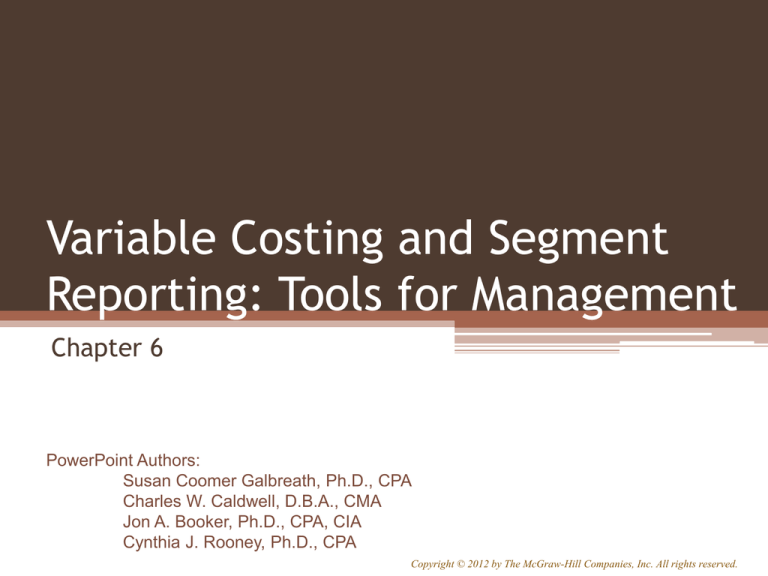
Variable Costing and Segment
Reporting: Tools for Management
Chapter 6
PowerPoint Authors:
Susan Coomer Galbreath, Ph.D., CPA
Charles W. Caldwell, D.B.A., CMA
Jon A. Booker, Ph.D., CPA, CIA
Cynthia J. Rooney, Ph.D., CPA
Copyright © 2012 by The McGraw-Hill Companies, Inc. All rights reserved.
6-2
Learning Objective 1
Explain how variable
costing differs from
absorption costing and
compute unit product
costs under each
method.
6-3
Overview of Variable and
Absorption Costing
Variable
Costing
Absorption
Costing
Direct Materials
Product
Costs
Direct Labor
Variable Manufacturing Overhead
Product
Costs
Fixed Manufacturing Overhead
Period
Costs
Variable Selling and Administrative Expenses
Fixed Selling and Administrative Expenses
Period
Costs
6-4
Quick Check
Which method will produce the highest values
for work in process and finished goods
inventories?
a. Absorption costing.
b. Variable costing.
c. They produce the same values for these
inventories.
d. It depends. . .
6-5
Quick Check
Which method will produce the highest values
for work in process and finished goods
inventories?
a. Absorption costing.
b. Variable costing.
c. They produce the same values for these
inventories.
d. It depends. . .
6-6
Unit Cost Computations
Harvey Company produces a single product
with the following information available:
6-7
Unit Cost Computations
Unit product cost is determined as follows:
Under absorption costing, all production costs, variable
and fixed, are included when determining unit product
cost. Under variable costing, only the variable
production costs are included in product costs.
6-8
Learning Objective 2
Prepare income
statements using both
variable and absorption
costing.
6-9
Variable and Absorption Costing
Income Statements
Let’s assume the following additional information
for Harvey Company.
▫ 20,000 units were sold during the year at a price
of $30 each.
▫ There is no beginning inventory.
Now, let’s compute net operating
income using both absorption
and variable costing.
6-10
Variable Costing Contribution Format
Income Statement
All fixed
Variable
manufacturing
costs only.
manufacturing
overhead is
expensed.
Variable Costing
Sales (20,000 × $30)
Less variable expenses:
Variable cost of goods sold (20,000 × $10)
Variable selling & administrative
expenses (20,000 × $3)
Total variable expenses
Contribution margin
Less fixed expenses:
Fixed manufacturing overhead
Fixed selling & administrative expenses
Net operating income
$ 600,000
$ 200,000
60,000
260,000
340,000
$ 150,000
100,000
250,000
$ 90,000
6-11
Absorption Costing Income Statement
Unit product
cost.
Fixed manufacturing overhead deferred in
inventory is 5,000 units × $6 = $30,000.
6-12
Learning Objective 3
Reconcile variable costing
and absorption costing
net operating incomes
and explain why the two
amounts differ.
6-13
Comparing the Two Methods
6-14
Comparing the Two Methods
We can reconcile the difference between
absorption and variable income as follows:
Variable costing net operating income
$ 90,000
Add: Fixed mfg. overhead costs
deferred in inventory
(5,000 units × $6 per unit)
30,000
Absorption costing net operating income $ 120,000
Fixed mfg. overhead
$150,000
=
= $6 per unit
Units produced
25,000 units
6-15
Extended Comparisons of Income
Data Harvey Company – Year Two
6-16
Unit Cost Computations
Since the variable costs per unit, total fixed costs,
and the number of units produced remained
unchanged, the unit cost computations also
remain unchanged.
6-17
Variable Costing Contribution Format
Income Statement
All fixed
Variable
manufacturing
costs only.
manufacturing
overhead is
expensed.
Variable Costing
Sales (30,000 × $30)
Less variable expenses:
Variable cost of goods sold (30,000 × $10)
Variable selling & administrative
expenses (30,000 × $3)
Total variable expenses
Contribution margin
Less fixed expenses:
Fixed manufacturing overhead
Fixed selling & administrative expenses
Net operating income
$ 900,000
$ 300,000
90,000
390,000
510,000
$ 150,000
100,000
250,000
$ 260,000
6-18
Absorption Costing Income Statement
Unit product
cost.
Fixed manufacturing overhead released from
inventory is 5,000 units × $6 = $30,000.
6-19
Comparing the Two Methods
We can reconcile the difference between
absorption and variable income as follows:
Variable costing net operating income
$ 260,000
Deduct: Fixed manufacturing overhead
costs released from inventory
(5,000 units × $6 per unit)
30,000
Absorption costing net operating income $ 230,000
Fixed mfg. overhead
$150,000
=
= $6 per unit
Units produced
25,000 units
6-20
Comparing the Two Methods
6-21
Summary of Key Insights
6-22
Enabling CVP Analysis
Variable costing categorizes costs as fixed and
variable so it is much easier to use this income
statement format for CVP analysis.
Because absorption costing assigns fixed
manufacturing overhead costs to units produced ($6
per unit for Harvey Company), a portion of fixed
manufacturing overhead resides in inventory when
units remain unsold. The potential result is positive
operating income when the number of units sold is
less than the breakeven point.
6-23
Explaining Changes in Net Operating
Income
Variable costing income is only affected by
changes in unit sales. It is not affected by
the number of units produced. As a general
rule, when sales go up, net operating
income goes up, and vice versa.
Absorption costing income is influenced by
changes in unit sales and units of
production. Net operating income can be
increased simply by producing more units
even if those units are not sold.
6-24
Supporting Decision Making
Variable costing correctly identifies the additional
variable costs incurred to make one more unit ($10
per unit for Harvey Company). It also emphasizes
the impact of total fixed costs on profits.
Because absorption costing assigns fixed
manufacturing overhead costs to units produced ($6
per unit for Harvey Company), it gives the impression
that fixed manufacturing overhead is variable with
respect to the number of units produced, but it is not.
The result can be inappropriate pricing decisions and
product discontinuation decisions.
6-25
Variable Costing and the Theory of
Constraints (TOC)
Companies involved in TOC use a form of variable
costing. However, one difference of the TOC
approach is that it treats direct labor as a fixed cost
for three reasons:
Many companies have a commitment to guarantee
workers a minimum number of paid hours.
Direct labor is usually not the constraint.
TOC emphasizes the role direct laborers play in driving
continuous improvement. Since layoffs often devastate
morale, managers involved in TOC are extremely
reluctant to lay off employees.
6-26
Learning Objective 4
Prepare a segmented
income statement that
differentiates traceable
fixed costs from common
fixed costs and use it to
make decisions.
6-27
Decentralization and Segment
Reporting
An Individual Store
Quick Mart
A segment is any part
or activity of an
organization about
which a manager
seeks cost, revenue,
or profit data.
A Sales Territory
A Service Center
6-28
Keys to Segmented Income Statements
There are two keys to building
segmented income statements:
A contribution format should be used
because it separates fixed from variable
costs and it enables the calculation of a
contribution margin.
Traceable fixed costs should be separated
from common fixed costs to enable the
calculation of a segment margin.
6-29
Identifying Traceable Fixed Costs
Traceable fixed costs arise because of the
existence of a particular segment and would
disappear over time if the segment itself
disappeared.
No computer
division means . . .
No computer
division manager.
6-30
Identifying Common Fixed Costs
Common fixed costs arise because of the
overall operation of the company and would
not disappear if any particular segment were
eliminated.
No computer
division but . . .
We still have a
company president.
6-31
Traceable Costs Can Become
Common Costs
It is important to realize that the traceable
fixed costs of one segment may be a
common fixed cost of another segment.
For example, the landing fee
paid to land an airplane at an
airport is traceable to the
particular flight, but it is not
traceable to first-class,
business-class, and
economy-class passengers.
6-32
Segment Margin
Profits
The segment margin, which is computed by
subtracting the traceable fixed costs of a segment
from its contribution margin, is the best gauge of
the long-run profitability of a segment.
Time
6-33
Traceable and Common Costs
Fixed
Costs
Traceable
Don’t allocate
common costs to
segments.
Common
6-34
Levels of Segmented Statements
Webber, Inc. has two divisions.
W e bb e r, In c.
C o m p u te r D ivis ion
T e le vis io n Divis ion
Let’s look more closely at the Television
Division’s income statement.
6-35
Levels of Segmented Statements
Our approach to segment reporting uses the
contribution format.
Income Statement
Contribution Margin Format
Television Division
Sales
$ 300,000
Variable COGS
120,000
Other variable costs
30,000
Total variable costs
150,000
Contribution margin
150,000
Traceable fixed costs
90,000
Division margin
$ 60,000
Cost of goods
sold consists of
variable
manufacturing
costs.
Fixed and
variable costs
are listed in
separate
sections.
6-36
Levels of Segmented Statements
Our approach to segment reporting uses the
contribution format.
Income Statement
Contribution Margin Format
Television Division
Sales
$ 300,000
Variable COGS
120,000
Other variable costs
30,000
Total variable costs
150,000
Contribution margin
150,000
Traceable fixed costs
90,000
Division margin
$ 60,000
Contribution margin
is computed by
taking sales minus
variable costs.
Segment margin
is Television’s
contribution
to profits.
6-37
Levels of Segmented Statements
Sales
Variable costs
CM
Traceable FC
Division margin
Common costs
Net operating
income
Income Statement
Company
Television
$ 500,000
$ 300,000
230,000
150,000
270,000
150,000
170,000
90,000
100,000
$ 60,000
Computer
$ 200,000
80,000
120,000
80,000
$ 40,000
6-38
Levels of Segmented Statements
Sales
Variable costs
CM
Traceable FC
Division margin
Common costs
Net operating
income
Income Statement
Company
Television
$ 500,000
$ 300,000
230,000
150,000
270,000
150,000
170,000
90,000
100,000
$ 60,000
25,000
$
75,000
Computer
$ 200,000
80,000
120,000
80,000
$ 40,000
Common costs should not
be allocated to the
divisions. These costs
would remain even if one
of the divisions were
eliminated.
6-39
Traceable Costs Can Become
Common Costs
As previously mentioned, fixed costs that
are traceable to one segment can become
common if the company is divided into
smaller segments.
Let’s see how this works
using the Webber, Inc.
example!
6-40
Traceable Costs Can Become
Common Costs
Webber’s Television Division
Television
Division
Regular
Big Screen
Product
Lines
6-41
Traceable Costs Can Become
Common Costs
Income Statement
Television
Division
Regular
Sales
$ 200,000
Variable costs
95,000
CM
105,000
Traceable FC
45,000
Product line margin
$ 60,000
Common costs
Divisional margin
Big Screen
$ 100,000
55,000
45,000
35,000
$ 10,000
We obtained the following information from
the Regular and Big Screen segments.
6-42
Traceable Costs Can Become
Common Costs
Income Statement
Television
Division
Regular
Sales
$ 300,000
$ 200,000
Variable costs
150,000
95,000
CM
150,000
105,000
Traceable FC
80,000
45,000
Product line margin
70,000
$ 60,000
Common costs
10,000
Divisional margin
$ 60,000
Big Screen
$ 100,000
55,000
45,000
35,000
$ 10,000
Fixed costs directly traced
to the Television Division
$80,000 + $10,000 = $90,000
6-43
Segmented Income Statements and
Decision Making
5% increase in sales
Income Statement
Television
Division
Regular
Sales
$ 315,000
$ 210,000
Variable costs
157,500
99,750
CM
157,500
110,250
Traceable FC
80,000
45,000
Product line margin
77,500
$ 65,250
Common costs
15,000
Divisional margin
$ 62,500
$5,000 additional
advertising
Division margin
increases by
$2,500
Big Screen
$ 105,000
57,750
47,250
35,000
$ 12,250
Margin
increases
by $5,250
Margin
increases
by $2,250
6-44
Omission of Costs
Costs assigned to a segment should include
all costs attributable to that segment from the
company’s entire value chain.
Business Functions
Making Up The
Value Chain
R&D
Product
Design
Customer
Manufacturing Marketing Distribution Service
6-45
Inappropriate Methods of Allocating
Costs Among Segments
Failure to trace
costs directly
Segment
1
Segment
2
Inappropriate
allocation base
Segment
3
Segment
4
6-46
Common Costs and Segments
Common costs should not be arbitrarily allocated to segments
based on the rationale that “someone has to cover the
common costs” for two reasons:
1. This practice may make a profitable business segment appear
to be unprofitable.
2. Allocating common fixed costs forces managers to be held
accountable for costs they cannot control.
Segment
1
Segment
2
Segment
3
Segment
4
6-47
Quick Check
Income Statement
Sales
Variable costs
CM
Traceable FC
Segment margin
Common costs
Profit
Hoagland's
Lakeshore
$ 800,000
310,000
490,000
246,000
244,000
200,000
$ 44,000
Bar
$ 100,000
60,000
40,000
26,000
$ 14,000
Restaurant
$ 700,000
250,000
450,000
220,000
$ 230,000
Assume that Hoagland's Lakeshore prepared its
segmented income statement as shown.
6-48
Quick Check
How much of the common fixed cost of
$200,000 can be avoided by eliminating the
bar?
a. None of it.
b. Some of it.
c. All of it.
6-49
Quick Check
How much of the common fixed cost of
$200,000 can be avoided by eliminating the
bar?
a. None of it.
b. Some of it.
c. All of it.
A common fixed cost
cannot be eliminated by
dropping one of the
segments.
6-50
Quick Check
Suppose square feet is used as the basis for
allocating the common fixed cost of $200,000.
How much would be allocated to the bar if the
bar occupies 1,000 square feet and the
restaurant 9,000 square feet?
a. $20,000
b. $30,000
c. $40,000
d. $50,000
6-51
Quick Check
Suppose square feet is used as the basis for
allocating the common fixed cost of $200,000.
How much would be allocated to the bar if the
bar occupies 1,000 square feet and the
restaurant 9,000 square feet?
a. $20,000
b. $30,000
c. $40,000
d. $50,000
The bar would be
allocated 1/10 of the cost
or $20,000.
6-52
Quick Check
If Hoagland's allocates its common
costs to the bar and the restaurant,
what would be the reported profit of
each segment?
6-53
Allocations of Common Costs
Income Statement
Sales
Variable costs
CM
Traceable FC
Segment margin
Common costs
Profit
Hoagland's
Lakeshore
$ 800,000
310,000
490,000
246,000
244,000
200,000
$ 44,000
Bar
$ 100,000
60,000
40,000
26,000
14,000
20,000
$
(6,000)
Restaurant
$ 700,000
250,000
450,000
220,000
230,000
180,000
$ 50,000
Hurray, now everything adds up!!!
6-54
Quick Check
Should the bar be eliminated?
a. Yes
b. No
6-55
Quick Check
Should the bar be eliminated?
a. Yes
b. No
Sales
Variable costs
CM
Traceable FC
Segment margin
Common costs
Profit
The profit was $44,000 before
eliminating the bar. If we eliminate
the bar,
profit drops to $30,000!
Income
Statement
Hoagland's
Lakeshore
$ 700,000
250,000
450,000
220,000
230,000
200,000
$ 30,000
Bar
Restaurant
$ 700,000
250,000
450,000
220,000
230,000
200,000
$ 30,000
6-56
Companywide Income
Statements
Global View
Both U.S. GAAP and
IFRS require absorption costing
for external reports.
Since absorption costing is required for
external reporting, most companies also use
it for internal reports rather than incurring the
additional cost of maintaining a separate
variable cost system for internal reporting.
6-57
Variable versus Absorption Costing
Fixed manufacturing
costs must be assigned
to products to properly
match revenues and
costs.
Absorption
Costing
Fixed manufacturing
costs are capacity costs
and will be incurred
even if nothing is
produced.
Variable
Costing
6-58
Segmented Financial
Information
Global View
Both U.S. GAAP and IFRS require publically
traded companies to include segmented
financial data in their annual reports.
1. Companies must report segmented results to
shareholders using the same methods that are used
for internal segmented reports.
2. This requirement motivates managers to avoid using
the contribution approach for internal reporting
purposes because if they did they would be required
to:
a. Share this sensitive data with the public.
b. Reconcile these reports with applicable
rules for consolidated reporting purposes.
6-59
End of Chapter 6


